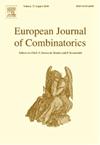完全二部图的奇拉姆齐数
IF 0.9
3区 数学
Q1 MATHEMATICS
引用次数: 0
摘要
在他对图码的研究中,Alon引入了Kn中图族H的奇拉姆齐数的概念,定义为为Kn的边上色所需的最小颜色数,使得图H∈H的每一个副本与某个颜色类在奇数条边上相交。本文主要讨论完全二部图。首先,我们完全解决了H是n个顶点上的所有生成完全二部图的族的问题。然后,我们专注于其亚科,{Kt, n−t: t∈t}一组固定的整数t⊆[⌊n / 2⌋]。我们证明了奇拉姆齐问题等价于确定一个避免给定权重码字的线性二进制码的最大维数,并利用编码理论的已知结果在我们的设置中推导出渐近紧界。我们得到了固定(即非生成)完全二部子图的奇拉姆齐数的界。本文章由计算机程序翻译,如有差异,请以英文原文为准。
Odd-Ramsey numbers of complete bipartite graphs
In his study of graph codes, Alon introduced the concept of the odd-Ramsey number of a family of graphs in , defined as the minimum number of colours needed to colour the edges of so that every copy of a graph intersects some colour class in an odd number of edges. In this paper, we focus on complete bipartite graphs. First, we completely resolve the problem when is the family of all spanning complete bipartite graphs on vertices. We then focus on its subfamilies, that is, for a fixed set of integers . We prove that the odd-Ramsey problem is equivalent to determining the maximum dimension of a linear binary code avoiding codewords of given weights, and leverage known results from coding theory to deduce asymptotically tight bounds in our setting. We conclude with bounds for the odd-Ramsey numbers of fixed (that is, non-spanning) complete bipartite subgraphs.
求助全文
通过发布文献求助,成功后即可免费获取论文全文。
去求助
来源期刊
CiteScore
2.10
自引率
10.00%
发文量
124
审稿时长
4-8 weeks
期刊介绍:
The European Journal of Combinatorics is a high standard, international, bimonthly journal of pure mathematics, specializing in theories arising from combinatorial problems. The journal is primarily open to papers dealing with mathematical structures within combinatorics and/or establishing direct links between combinatorics and other branches of mathematics and the theories of computing. The journal includes full-length research papers on important topics.

 求助内容:
求助内容: 应助结果提醒方式:
应助结果提醒方式:


